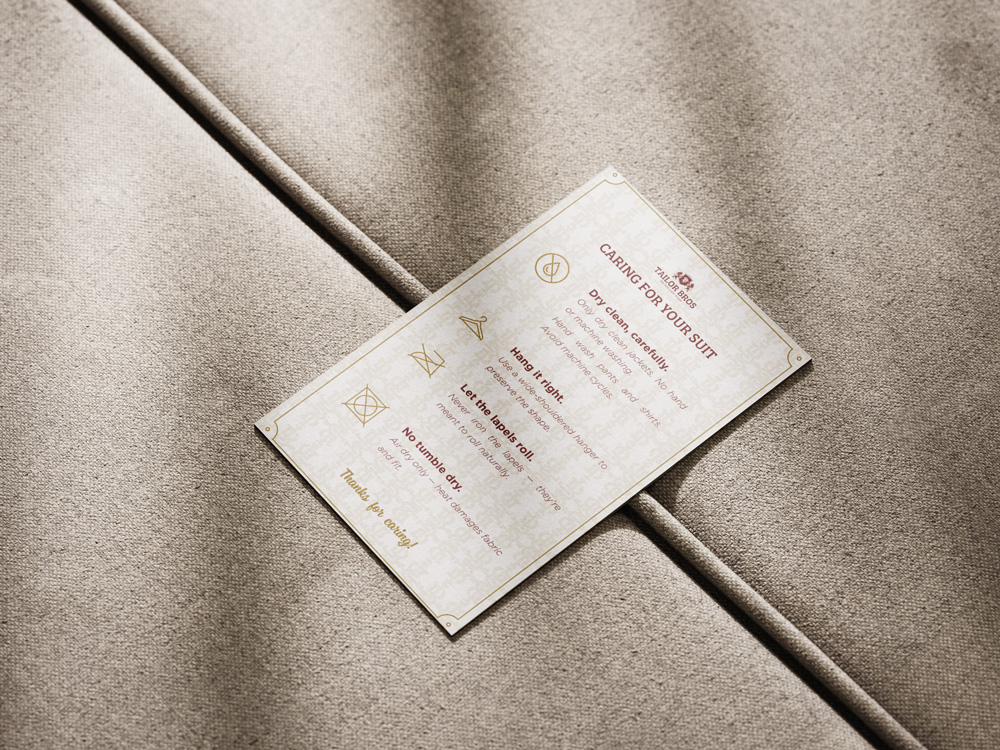Introduction
A tailored suit is more than clothing, it is an investment in craftsmanship, fabric, and personal style. To preserve its shape, drape, and elegance, proper care is essential. Unlike casual garments, a suit requires specific cleaning and storage methods to ensure longevity. This guide covers everything you need to know about how to clean, store, and maintain your suit so it looks impeccable for years to come.
1. How Often Should You Clean a Suit?

Do not dry clean too often. Excessive dry cleaning wears down natural fibers like wool and linen.
A general rule: dry clean only after 4–6 wears or if the suit is visibly stained.
For regular refreshment, use a garment brush and a steamer, not detergent.
Let your suit rest: avoid wearing the same suit two days in a row to allow fabric to recover.
2. Brushing and Steaming: The Everyday Care
Brush your suit after each wear with a horsehair brush to remove dust and lint.
Steam lightly to remove wrinkles and kill bacteria, this is gentler than ironing.
Important note: Never press directly on the lapel. The lapel’s natural roll is a hallmark of fine tailoring; excessive pressing can flatten it permanently. Always steam from the underside if needed.
3. Storing Your Suit Correctly
Use the Right Hanger
Invest in wide, contoured wooden hangers to support the shoulders.
Avoid thin wire hangers, which distort the shape.
Protect With a Garment Bag
Use breathable garment bags (cotton or canvas) for long-term storage.
Avoid plastic covers, which trap moisture and encourage mildew.
Rotate and Rest
Give each suit a day or two of rest between wears. This helps the fabric recover and prolongs lifespan.
4. Traveling With a Suit
Use a quality suit carrier or garment bag.
If folding is necessary, turn the jacket inside out at the shoulders and fold gently along the seams to minimize creasing.
Once arrived, hang the suit immediately and steam out light wrinkles.
5. Dealing With Stains and Odors
Spot clean immediately with a damp cloth and mild soap, never rub aggressively.
For oil-based stains, sprinkle talcum powder, let it absorb, and brush off gently.
Avoid perfumes or deodorants directly on fabric; these can stain wool or linen.
To remove odors, air out the suit in fresh air instead of over-cleaning.
6. Seasonal Maintenance
For summer suits (linen, hopsack, fresco): store in a cool, dry place, and avoid overcrowding to prevent wrinkles.
For winter suits (flannel, tweed, cashmere): ensure they are moth-protected; cedar blocks or lavender sachets are natural options.
Before storing suits long-term, dry clean them to prevent moths from being attracted to body oils or food particles.
7. Professional Care and Alterations
Establish a relationship with a trusted dry cleaner familiar with fine tailoring.
When pressing is required, request light steam pressing only, not heavy ironing.
For suits that no longer fit perfectly, invest in small alterations (waist suppression, sleeve adjustments) rather than replacing them.
Conclusion

Caring for your suit is as important as choosing the right fabric or cut. With the right routine: brushing, steaming, proper storage, and minimal dry cleaning, your suit will retain its elegance and shape for years. Remember the golden rule: never press directly on the lapel, let it roll naturally. This subtle detail preserves the character of your tailoring, honoring the craftsmanship that went into it.
By treating your suit with respect, you ensure that it remains not just clothing, but a timeless expression of style.

